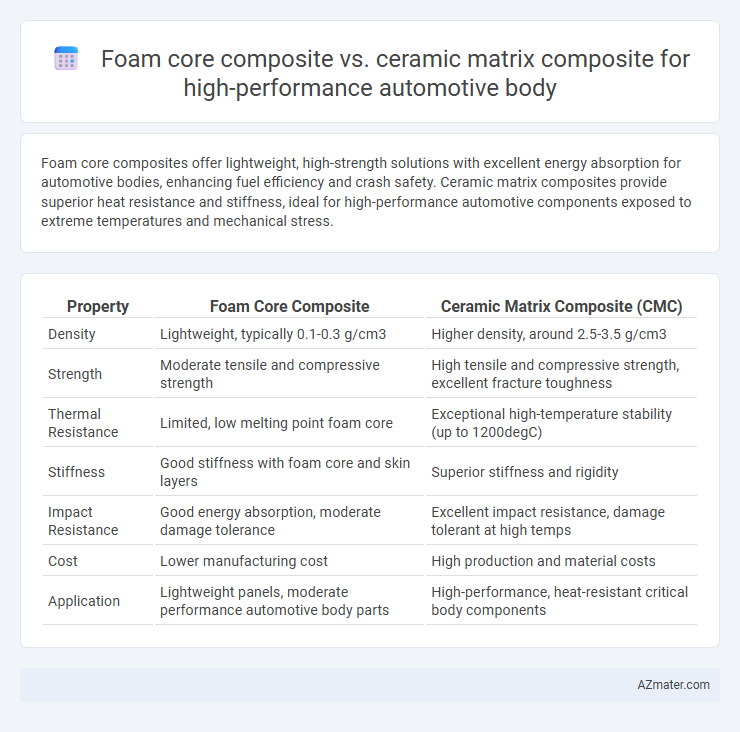Foam core composites offer lightweight, high-strength solutions with excellent energy absorption for automotive bodies, enhancing fuel efficiency and crash safety. Ceramic matrix composites provide superior heat resistance and stiffness, ideal for high-performance automotive components exposed to extreme temperatures and mechanical stress.
Table of Comparison
| Property | Foam Core Composite | Ceramic Matrix Composite (CMC) |
|---|---|---|
| Density | Lightweight, typically 0.1-0.3 g/cm3 | Higher density, around 2.5-3.5 g/cm3 |
| Strength | Moderate tensile and compressive strength | High tensile and compressive strength, excellent fracture toughness |
| Thermal Resistance | Limited, low melting point foam core | Exceptional high-temperature stability (up to 1200degC) |
| Stiffness | Good stiffness with foam core and skin layers | Superior stiffness and rigidity |
| Impact Resistance | Good energy absorption, moderate damage tolerance | Excellent impact resistance, damage tolerant at high temps |
| Cost | Lower manufacturing cost | High production and material costs |
| Application | Lightweight panels, moderate performance automotive body parts | High-performance, heat-resistant critical body components |
Introduction to High-Performance Automotive Body Materials
High-performance automotive body materials prioritize strength-to-weight ratio, thermal resistance, and durability under dynamic loads. Foam core composites offer lightweight structure with excellent energy absorption and ease of fabrication, ideal for weight reduction and crash performance. Ceramic matrix composites deliver superior high-temperature resistance and stiffness, enhancing thermal stability and structural integrity in extreme driving conditions.
Overview of Foam Core Composites
Foam core composites consist of a lightweight foam core sandwiched between fiber-reinforced polymer layers, offering superior strength-to-weight ratios crucial for high-performance automotive bodies. These composites provide excellent energy absorption, structural rigidity, and impact resistance while significantly reducing overall vehicle weight to improve fuel efficiency and handling. Advanced foam materials like PVC or PMI combined with carbon or glass fibers enhance thermal insulation and vibration damping properties essential for automotive applications.
Overview of Ceramic Matrix Composites
Ceramic Matrix Composites (CMCs) consist of ceramic fibers embedded in a ceramic matrix, offering exceptional high-temperature resistance and superior mechanical strength compared to traditional materials. In high-performance automotive bodies, CMCs provide enhanced thermal stability, reduced weight, and increased durability, enabling improved performance and fuel efficiency. Their ability to withstand extreme conditions while maintaining structural integrity makes CMCs a preferred choice over foam core composites in advanced automotive applications.
Mechanical Strength Comparison
Foam core composites exhibit excellent stiffness-to-weight ratios but generally have lower mechanical strength and impact resistance compared to ceramic matrix composites (CMCs), which offer superior tensile strength and thermal stability. CMCs demonstrate enhanced fracture toughness and high-temperature performance, making them more suitable for demanding structural applications in high-performance automotive bodies. While foam core composites excel in lightweight design, CMCs provide significant advantages in mechanical robustness and durability under extreme loading conditions.
Weight and Density Considerations
Foam core composites exhibit significantly lower density, typically around 0.1-0.3 g/cm3, providing exceptional lightweight benefits for high-performance automotive bodies. In contrast, ceramic matrix composites (CMCs) have higher densities, approximately 2.5-3.5 g/cm3, resulting in increased structural weight despite superior thermal and wear resistance. The lightweight nature of foam core composites enables enhanced fuel efficiency and handling performance, while CMCs offer durability at the expense of additional mass.
Thermal Resistance and Insulation Properties
Foam core composites offer excellent thermal insulation due to their low density and closed-cell structure, making them ideal for reducing heat transfer in high-performance automotive bodies. Ceramic matrix composites provide superior thermal resistance withstanding temperatures exceeding 1,200degC while maintaining structural integrity under extreme thermal cycling. Balancing lightweight foam core composites with high-temperature-resistant ceramic matrix composites can optimize thermal management and insulation in advanced automotive body applications.
Impact Resistance and Crash Safety
Foam core composites offer excellent energy absorption and lightweight properties, making them highly effective for impact resistance in high-performance automotive bodies. Ceramic matrix composites provide superior thermal stability and stiffness but are more brittle, which can reduce crash safety performance under high-impact conditions. Combining foam core composites with ceramic matrix layers can optimize both impact resistance and crash safety by balancing energy absorption and structural integrity.
Manufacturing Processes and Scalability
Foam core composites utilize lightweight polymer foams as cores bonded with fiber-reinforced polymer skins, enabling efficient fabrication through processes like vacuum bagging and resin transfer molding, which are cost-effective and suitable for medium to large-scale automotive production. Ceramic matrix composites (CMCs) are produced via complex techniques such as chemical vapor infiltration or slurry impregnation, requiring high-temperature processing and extended cycle times that limit scalability and increase manufacturing costs. Foam core composites offer better scalability and lower production complexity for high-performance automotive bodies, while ceramic matrix composites provide superior thermal and mechanical properties at the expense of manufacturing speed and scalability.
Cost-Benefit Analysis for Automotive Applications
Foam core composites offer a lightweight, cost-effective solution with excellent energy absorption and easier manufacturing, making them suitable for mass-produced high-performance automotive bodies. Ceramic matrix composites provide superior thermal resistance and structural durability at a significantly higher material and processing cost, justifiable primarily in extreme performance or high-temperature environments such as racing applications. The cost-benefit analysis favors foam core composites for broad automotive use due to their balance of price, weight reduction, and impact performance, while ceramic matrix composites remain niche for peak performance needs despite their premium cost.
Future Trends and Innovations in Composite Materials
Foam core composites offer lightweight structures with excellent impact energy absorption, making them ideal for high-performance automotive bodies focusing on weight reduction and enhanced crash safety. Ceramic matrix composites provide superior thermal stability and wear resistance, enabling improved durability and performance in engine components and braking systems under extreme conditions. Future trends emphasize hybridizing foam core and ceramic matrix composites through advanced manufacturing techniques like additive manufacturing and nanomaterial integration to optimize strength-to-weight ratios and multifunctionality in next-generation automotive designs.

Infographic: Foam core composite vs Ceramic matrix composite for High-performance automotive body
 azmater.com
azmater.com